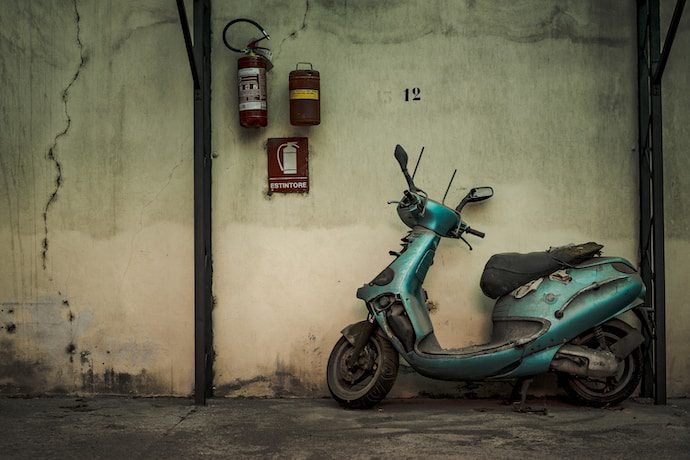
Recognizing Indications of a Defective Motorcycle Battery
It is a common misconception that the motorcycle battery provides the current required to run the engine and operate electrical components in a motorcycle.
The truth is that the battery only provides initial current and the alternator does the rest. That said your motorcycle cannot work without a battery and when it starts to fail, you will notice some tell-tale signs.
The battery in any vehicle, including a motorcycle, is the vehicle’s powerhouse. It supplies current required to start the engine after which the alternator takes over.
The battery also provides additional current which may be required when that produced by the alternator is lower than what is being drawn from it. This would usually happen when you are stuck in slow traffic or riding at very low speed.
Like all other car parts, the battery has a lifespan that eventually comes to an end. When a battery’s life is nearing its end, you will notice certain tell-tale signs that should warn you so that you are not caught flat-footed when it eventually fails completely.
You may notice that it takes more than the usual one try to get the engine started. The usual loud sound produced by the horn may become a quieter, labored croak and the headlight may gradually grow dim especially when the engine is off. Other signs are an inability to re-charge to full voltage and wide ranges in voltage readings.
Signs of a Bad Motorcycle Battery
Engine doesn’t start
Starting the engine of a motor cycle works more or less the same as it does in a car. The starter motor depends solely on the battery to provide sufficient power to crank up the engine.
The motor demands a fairly high voltage from the battery so if there isn’t sufficient charge in the battery, you may have to try starting the engine several times before it eventually does. As the battery continues to weaken, it takes more and more effort to crank up the engine.
If the battery is completely dead, there is no response at all. Attempting to turn the key or push the start button produces nothing but silence.
Fading headlights and horn
Both headlights and horns draw power from the motorcycle battery when the engine is off. When it comes to headlights, the number of amps required for the headlights depends on the wattage of the bulb. The brighter the light, the more power required to turn it on and keep it on.
If you would like to install a new set of lights on your motorcycle, you will need to find out how much your bike’s electrical system can support without becoming overburdened.
Use the owner’s manual as a guide. For instance if your motorcycle produces 400 watts, find out how much of it is utilized by existing electrical components. Is there enough left over to support your new headlight?
When batteries begin to fail, you may find that the lights still come on but are not as bright as they used to be. When you turn them on, they may cover a shorter range than they used to.
The horn on the other hand requires almost insignificant amounts of power. That said, if the battery has insufficient charge, even the little required by the horn is unavailable. If some, but minimal power is available you may notice the volume of the horn has reduced. Another sign is a horn which produces a sound but nothing like it always has. It may sound like a low, dull croak rather than the usual loud, steady beep.
Varying Mutimeter Readings
A multimeter is a simple tool used to measure electric current and voltage of a battery. Motorcycle owners are encouraged to invest in one in order to check the state of the battery at any time easily. This way you don’t have to take the bike to the shop to get a simple multimeter reading.
When a battery is failing, you may notice wide variations in multimeter readings even if it’s been just a couple of minutes since the last reading.
Failure to charge fully: The average lifespan of a lead-acid motorcycle battery is 4 to 5 years. In hot climates, this lifespan drops to about 3 years. If you have an aging battery that is approaching the end of its life, this is one of the symptoms you are likely to observe.
A fully charged battery should have at least 12.6 volts. If it has been charging for longer than it ordinarily needs to fill up and still cannot get any higher than 10.5 volts, then it is probably time to replace it.
A faulty alternator could also cause this so you would have to confirm that the alternator is working fine before coming to this conclusion.
Components of a Motorcycle Electrical System
It is one thing to know the signs of a bad motorcycle battery and it is another to understand exactly why these symptoms are observed. It takes a basic understanding of the components of the motorcycle’s electric system. These are: a battery, an alternator and a rectifier, also known as a regulator.
Battery
The 12-volt battery is a six-cell unit. Each cell has a positive and negative plate immersed in an electrolyte. Each cell’s voltage is about 2.1 volts when fully charged. This means the 6 cells, have a combined voltage of 12.6 volts when fully charged.
The battery produces Direct Current (DC) to power the motorcycle’s electronics when the engine is off. It is also responsible for providing current to crank the engine up when the start button is pressed.
Alternator
This component takes over from the battery as soon as the engine is started. It generates electricity to power the electrical components. The engine’s crankshaft turns the magnets and produces electricity as an electromagnet.
Rectifier/regulator
The alternator produces current but it is Alternating Current (AC) which must be converted to Direct Current (DC) to be utilized. This is where the rectifier comes in. It converts AC into DC and also regulates the amount of current being sent to the various electronics on the motorcycle.
Difference Between a Dead Battery and a Bad Battery
A dead battery is not necessarily a bad battery. However, it is just a matter of time before a bad battery becomes a dead battery.
If you don’t ride your motorcycle for a long time the engine may not start when you push the start button. The battery may die even if it is in perfect condition. This is quite common even with fairly new batteries. If you find yourself in this situation, all you need to do is jump start the battery, ride the motorcycle for a while and it will be back to perfect shape.
A bad battery on the other hand shows signs of failure even if it has been in continuous use. Even if a remedy is found to get it working again, such as jump starting, it fails again and again.
If you have a faulty battery which cannot start the engine, jump starting may help to get it running but as soon as the engine is turned off it doesn’t come on again.
Final Word
The typical lifespan of a battery is about 5 years. This could vary depending on how often the motorcycle is used and length of typical rides. Even then, a battery will eventually start to fail. With these signs in mind, you have no reason to get caught unaware when the battery eventually fails and must be replaced.
